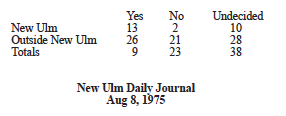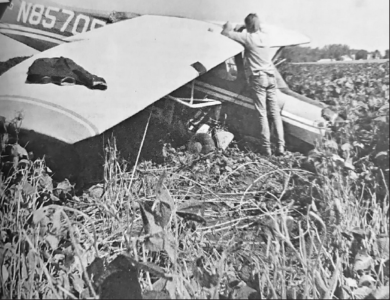Famous Battle of New Ulm painting moved for its own protection
ST. PAUL — A painting about the Battle of New Ulm during the 1862 Sioux Indian Uprising once hung in the State Capitol’s Rotunda. Now it hangs in a little-used hearing room.
The painting by New Ulm artist Anton Gag changed walls in 1973 for its own protection, according to Capitol authorities.
“ITS OWN protection” meant two things. To New Ulm Rep. A. J. Eckstein, it meant protection from possible damage by American Indian Movement (AIM) supporters during the 1973-74 Wounded Knee takeover and trial.
But to Minnesota Historical Society Audio-Visual Director Lila Goff, protection meant saving the painting from dirty fingers and tired heads of people who sat on a Rotunda bench under the painting.
The 1904 painting shows grim-faced, bare-backed Sioux Indians ready to attack New Ulm. As the pack of attackers, armed with long rifles, hatchets, and knives, tromp through a tall cornfield, an isolated building burns and a handful of white men scurry behind barricades to defend the main town.
It was war and the Indians were the enemy.
Leaders of current 20th century social awareness groups and AIM would like the savage, villainous Indian image to change. Moving the picture was a way to help the cause.
LEGISLATORS ALSO thought the Rotunda needed a painting of a “friendly” Indian. But the $1,000 some wanted to buy their friendly Indian with wasn’t enough. The money never got full legislative approval, either.
Wounded Knee and Indian awareness happened about the same time Historical Society people thought the Capitol needed some interior changes.
“The painting just didn’t fit in the Rotunda,” Goff said. Her department cares for and keeps track of all the paintings in the Capitol.
“The Rotunda wasn’t designed for a painting,” she said. So the Gag oil and another painting went off to committee hearing rooms.
CAPITOL VISITORS get better views of the art now that the oils have come from behind large Rotunda column that darken the rounded walls. Both paintings have prominent spots in well lighted rooms.
“We had to repair the New Ulm painting twice while it was in the Rotunda,” Goff said.”Now that people can see it and know it is there, we don’t worry so much about finger damage.”
Goff didn’t know much else about the painting. Her records didn’t say when the Historical Society got the painting or how long it had hung in the Rotunda.
But a 1949 biography of Gag’s daughter Wanda said the Historical Society had Gag’s painting that “had been exhibited at the Chicago World’s Fair.”
GAG SETTLED in New Ulm at age 13. He came from Bohemia in 1872 and learned to paint at Milwaukee and Chicago. Besides the 1904 battle scene, Gag did an 11-panel panorama of the Sioux Uprising.
The panels were discovered in a New York farmhouse attic and given to the Minnesota Historical Society in 1954. Much of the muslin and chalk work is in poor condition and is not publicly shown.
Three of the panels show scenes from New Ulm battles. The “Second Battle of New Ulm” shows town defenders led by Charles E. Flandrau fighting fist-to-cuff the attacking Indians.
Another shows surviving town folk limping off to Mankato after the Indians had been defeated.
THE SIOUX Indians lived on two reservations covering a narrow 60-mile strip along the Minnesota River. They had been put there in 1851 after selling 24million acres of farmland in southwestern Minnesota, part of South Dakota, and Iowa to the U. S. government for $1.6 million cash.
State historian Kenneth Carley said the Indians had become increasingly upset over the years with late government payments, shady trade deals, and farmers crowding the reservation to the northwest of New Ulm.
Summer 1862 seemed as good a time as any for the Indians to fight back. The white settlers had lost most of their men fighters to the Civil War and the Union Army, Indian crops had failed the winter before, and the government was a long two months overdue with gold payments.
THE INDIANS couldn’t get credit and when a storekeeper said “If they are hungry, let them eat grass,” the Indians had reached the last straw.
Carley said the white settlers couldn’t believe the Indians were attacking. Most of the area settlers were Germans who “had lived on friendly terms with the Sioux, whom they knew as wandering, usually hungry beggars,” according to Carley.
It seems ironic that after the Aug. 23second battle, victorious New Ulm survivors trudged off to Mankato, 30 miles southeast.
Colonel Flandrau said, “It was a melancholy spectacle to see 2,000 people, who a few days before had been prosperous and happy, reduced to utter beggary, starting on a journey through hostile country.”
With help from St. Peter and Mankato citizens, New Ulm residents crowded into the town’s main area of brick buildings for defense. More than 1,000 women and children piled into Erd House (now the Restaurant Eibner) for safety and William Mayo doctored the wounded in the Dacotah House-since torn down.
New Ulm Daily Journal
April 20, 1975


